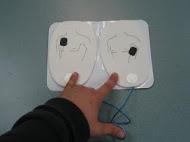Heart disease, stroke, and CPR

Training in cardiopulmonary resuscitation is a must. The most recent reports from the WHO show that the top causes of death in the world is heart disease, with stroke coming in at second. Ischemic heart disease is when some of the vessels that supply the heart with blood gradually get filled up with plaque. This leads to less blood flow to the heart muscles or a condition known as ischemia. Similarly, the same thing happens during a stroke but a stroke can happen in any vessel in the body that suddenly gets cut off from circulation. If the heart muscle doesn’t receive oxygenated blood, it will cause the heart to stop pumping.
Cardiopulmonary resuscitation uses rescue breaths and chest compressions to get the heart pumping oxygenated blood manually to the body. CPR is also used to try and get the heart to start beating on its own spontaneously. If the heartbeat is still irregular, defibrillation with an AED (automated external defibrillator) is done, usually when emergency medical services (EMS – the ambulance) arrive. CPR can help save a life if performed timely and adequately.
The CPR certificate
When you train to be a rescuer, be sure that you get certified. Training credentials are important if you work in a high risk job or want to volunteer in healthcare. Credentials certify that you have the necessary skills to give CPR and first aid. While no one is going to ask about your credentials during an emergency in a public place, documentation is a good thing to have.
We are training credentials to students once they complete their training and pass the post-test given at the end of the course. The post-test usually has a practical and a written portion. The certificates are valid for a total of 24 months. As they approach expiration, we can renew them for you if you sign up for re-certification. We do not renew certificates that have expired so be sure to renew before your 2 years is up.
CPR training programs
We have eight total CPR programs, 5 training and 3 re-certification programs. Three of the training programs fall under Basic Life Support while two are under Advanced Life Support. BLS and ALS training is very different. BLS programs are short and skill-orientated, with students learning how to give one and two-person CPR and first aid to a victim. These basic programs teach management of a victim before medical support arrives or before the victim is brought to an emergency room. They can be taken by the public – laymen – and healthcare providers (HCPs).
On the other hand, ALS programs teach the basic medical management given to a victim if he was in medical set up. That’s why ALS programs are only for HCPs with valid BLS training certification. Medical management includes the used of ECGs, oxygen support devices, and medication to stabilize the victim.
- Heartsaver (general public) – 4 hours, 1-person rescue and first aid
- Heartsaver C (HCPs) – 4.5 hours, 1-person rescue and first aid
- BLS for HCPs – 4.5 hours, 1 and 2-person rescue and first aid
- Advanced Cardiac Life Support – 16 hours, over 2 days; adult management
- Pediatric Advanced Life Support – 14 hours, over 2 days; pediatric management
